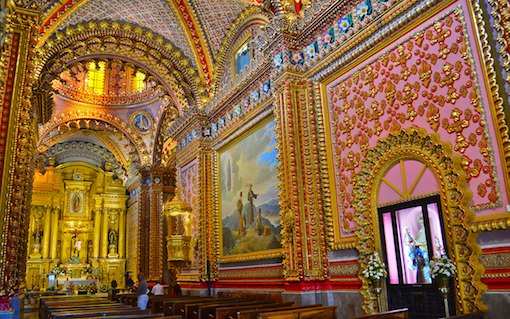
After spending a quiet Christmas in Puebla, my husband and I headed north to visit some friends in Morelia, the UNESCO World Heritage City and capital of the central Mexican state of Michoacán, destination of the beautiful monarch butterfly.
 The colonial city center’s narrow streets are lined with well-preserved 17th- and 18th-century buildings built from the region’s characteristic pink stone. One such building is the imposing, baroque-style Morelia Cathedral (pictured below). Its elegant, soaring twin towers preside over the city’s main square, Plaza de Armas.
The colonial city center’s narrow streets are lined with well-preserved 17th- and 18th-century buildings built from the region’s characteristic pink stone. One such building is the imposing, baroque-style Morelia Cathedral (pictured below). Its elegant, soaring twin towers preside over the city’s main square, Plaza de Armas.

We arrived in Morelia in the early evening and quickly settled into the Hotel Alameda, which is right on the corner of Zocolo. Being the holidays, the streets were brimming with people, but we were able to find an outdoor table at the cafe Panolino, where we shared a magnificent jamon serano sandwich and drank some delicious coffee. I watched with amusement as a boy at the next table attempted to eat a huge hambergesa that resembled a UFO. He examined it carefully, as if searching for a way in, yet somehow managed to eat the whole thing. Later, as the family was leaving, they passed beside our table and much to my amazement, the father paused to welcome us to Morelia and to enjoy our stay. It was such a friendly gesture that I instantly felt at ease.
 The next day we visited the exquisite Sanctuario de Guadalupe, where our friend’s mother, who was named after the Virgin of Guadalupe, got married. We were informed that the wedding waiting list is now a year and a half long.
The next day we visited the exquisite Sanctuario de Guadalupe, where our friend’s mother, who was named after the Virgin of Guadalupe, got married. We were informed that the wedding waiting list is now a year and a half long.
The Virgin of Guadalupe appeared in a vision to an indigenous man named Juan Diego on Dec. 9, 1531. Since then, she has become a powerful image of Mexican identity. Her complexion is that of a mestizo, a combination of Mexican and Spanish, indicating that she is for all people. Her gaze is one of compassion and motherly tenderness.

We also went on a bit of a gastronomical tour. Our friends brought us to a first rate restaurant that specializes in arracherra, a thin, marinated steak, and I must admit it was the best I ever ate. But in terms of decor, the San Miguelito restaurant was simply a knock out. Fittingly the food is also highly original.

Pictured in the centre of the photo is St. Anthony, hanging upside down. According to legend, this position will bring true love, so it has become the ideal spot to propose to a prospective partner. The open book below St. Anthony’s head lists the couples who became engaged here. If you are curious about the pictures on the wall and other decorations hanging from the ceiling, these are all for sale.
There are also two lovely day trips one can make from Morelia. The first is the beautiful  town of Patzcuaro, which has preserved an indigenous-colonial appearance and sits on a lake. It has a square known as Plaza Vasco de Quiroga or the Plaza Grande as well as numerous churches and shops offering local arts and crafts. There is also the quiet town of Cuitzeo, which features the magnificent 16th century Convento de Santa María Magdalena de Cuitzeo, which is well worth visiting.
town of Patzcuaro, which has preserved an indigenous-colonial appearance and sits on a lake. It has a square known as Plaza Vasco de Quiroga or the Plaza Grande as well as numerous churches and shops offering local arts and crafts. There is also the quiet town of Cuitzeo, which features the magnificent 16th century Convento de Santa María Magdalena de Cuitzeo, which is well worth visiting.


It looks and sounds like a lovely place, Elaine! Glad you are enjoying it.
LikeLike
Thank you, Diane. We had a lovely time and plan to go back.
LikeLike
How wonderful. How was reading Anna Karenina while in this magical landscape? I was reminded of a book you likely know about, where Aritha Van Herk reads Anna Karenina on a wilderness trek. I think I will track it down and re-read it myself. https://www.goodreads.com/book/show/607755.Places_Far_from_Ellsemere
LikeLike
To be perfectly honest, I had a hard time focusing on AK at the time. Thanks for the reference; it looks like fun!
LikeLike
That restaurant looks extraordinary. Morelia seems to be a city which combines modernity with tradition so as a modern tourist you can get about and yet there is still the reality of people’s deeper lives to see. I don’t know that I saw that while I and my daughters were in Milan. One might need to go out to the countryside in Italy; now and again in Rome Jim and I (we had five weeks) came into touch with this older life.
LikeLiked by 1 person
Yes, the historical centres of most Mexican cities have been preserved, restored and modernized. They are the places in which the tourists converge, but there is also nightlife for the locals. Each centre has a square, the Zócalo, and this is the traditional space for socializing. It is usually beside the church and consists of green space, walkways, and benches, sometimes even a fountain.
LikeLike